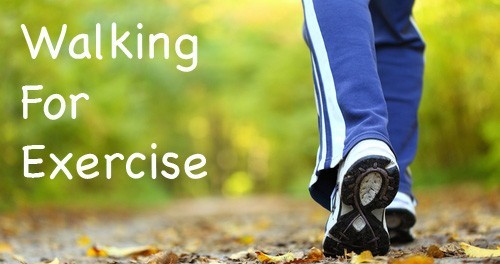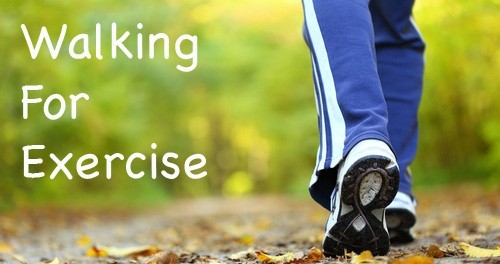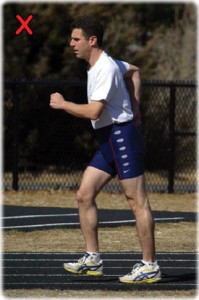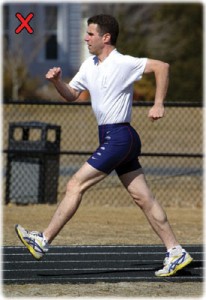Walk Talk Series
Day 65 – Training for Speed
Affirmation of the Day
The past is gone, the future uncertain. Today is now and I face it head on.
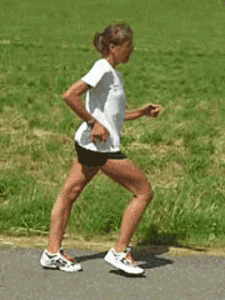 Today’s Walk: Health/Recovery Walk:
Today’s Walk: Health/Recovery Walk:
- 45-90 minute walk in the healthy heart zone 50-60% of your maximum heart rate
- Warm up with 5 minutes at a very easy pace
- Find a safe spot with a wall or pole to do a 5 minute easy stretching routine
- Now resume your walk at a comfortable pace
- End with 5 minutes of gentle stretching
Exercise: Upper Body Exercises
How fast are you walking?
Are you interested in learning to walk faster? Do you want to train to enter walking events that have a challenging time limit or relay races like Portland to Coast?
How to Walk Faster
Feel the need for speed? Walking faster can satisfy several goals.
- 1. Finish your walking workout faster at a set distance.
- 2. Get your heart rate up to your target level.
- 3. Increase calorie burn by being able to walk a longer distance in the same time, or by increasing speed to the point you are burning more calories due to using more muscles (12 minute miles and under).
- 4. Finish walking races in better time.
- The following techniques are not legal racewalking technique, and so it cannot be used in judged racewalk events. It borrows good posture, stride, arm movement and other elements from racewalking to have you walking faster and more efficiently, turning more of your exertion into forward speed
The following techniques are not legal racewalking technique, and so it cannot be used in judged racewalk events. It borrows good posture, stride, arm movement and other elements from racewalking to have you walking faster and more efficiently, turning more of your exertion into forward speed
Fast Walking Shoes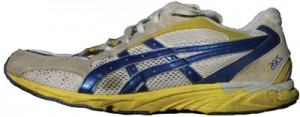
Your shoes are your chief walking tool. When trying to walk faster, you must find the right shoes or you will have pain and problems
-
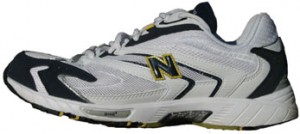 Running shoes vs. walking shoes: For walking fast, a running shoe will be your best choice. Running shoes incorporate the latest research into how the foot moves. Move away from cross-trainers, which are often inflexible, to the right running shoe.
Running shoes vs. walking shoes: For walking fast, a running shoe will be your best choice. Running shoes incorporate the latest research into how the foot moves. Move away from cross-trainers, which are often inflexible, to the right running shoe. - Fit: Your shoes must fit well, but leave enough room so your feet can expand while walking. Your walking shoes should be a size to a size and a half larger than your dress shoe.
- Flex: Good fast-walking shoes are flexible to allow your foot to roll through each step. See if your shoe bends in the ball of the foot and if you can twist it from side to side. If it is stiff as a board, you need different shoes.
- Flat: Walking shoes should be flat, with little difference in height between the heel and the ball of the foot.
- Heel: Avoid any heel flare, what you really need is a slightly undercut heel if you can find it.
- Where to Buy: Find out where the serious runners buy their shoes in your area and go there to be fitted. If the clerk doesn’t understand the terms over-pronation, straight last, or motion control — you haven’t found the right store. Good stores are listed in Runner’s World Magazine as technical athletic shoe stores.
- New Shoes: Replace your shoes every 500 miles.
Your Baseline
Before you get faster, take some baseline measurements to see how fast you are now and where your heart rate is.
Measured Mile: This is a good standard measurement. Use a local track or measure a mile with your car odometer. Time yourself in walking this mile after you have warmed up for 5-10 minutes of walking.
Heart Rate: Knowing what heart rate you currently achieve while walking can help you set goals when you speed up. Warm up first by walking for at least 5 minutes. Then take your pulse while continuing to walk. Measuring for 30 seconds to a minute will give you better accuracy. Or, you may use a heart rate monitor.
Fast Walking Technique
Walking faster begins by walking with the right technique at any speed, a technique that has your body aligned, legs and arms working together to transmit energy and power to your stride, and no wasted motion. You may need to slow down at first and concentrate on good technique before you let the right technique take you to new speed.
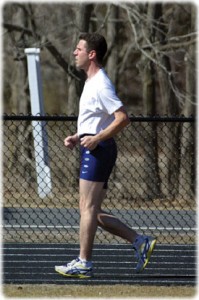 Using the Right Technique Will Help Prevent Injury.
Using the Right Technique Will Help Prevent Injury.
You can expect to be stiff in some new places as you learn a new technique. This should work itself out, use the stretches to get looser and be sure to include the warm-up and cool-down phases in each workout. Pain beyond stiffness that doesn’t go away should be checked out with your medical provider.
Head and Torso
How you hold your body is very important to walking comfortably and easily. With good posture you will be able to breathe easier and you will avoid back pain.
- Stand up straight
- Think of being tall and straight, do not arch your back
- Do not lean back or sit back on your your hips, this strains the back
- Some coaches recommend leaning forward 5 degrees, but this usually results in too much lean, not improving speed
- Eyes forward, not looking down but rather 20 feet ahead
- Chin up (parallel to the ground). This reduces strain on neck and back
- Relax your jaw and avoid tension in your neck
- Shrug once and let your shoulders fall and relax, your shoulders slightly back.
- Do not hike up your shoulders or tense them
- Suck in your stomach – keep your abdominal muscles firm but not overtightened
- Tuck in your behind – rotate your hip forward slightly. This will keep you from arching your back
- Your head should remain level as you walk, all motion takes place from the shoulders down
- Your hips will rotate front to back as you walk, avoid side-to-side swaying which is wasted motion
Arm Motion
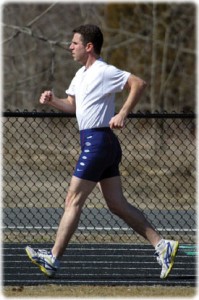
Arm motion can lend power to your walking, acting as a balance to your leg motion. If done properly, it looks natural and fluid.
- Bend your elbow 90 degrees
- Hands should be loose in a partially closed curl, never clenched
- Keep your elbows close to your body – don’t “chicken wing”
- With each step, the arm on the same side as your forward foot goes straight back, as if reaching for something in your hip pocket
- As the foot goes back, the opposite arm comes straight forward, not diagonally
- Your forward hand should not cross the center point of your body
- Your hand when coming forward should be kept low, not higher than your breastbone
- Many poor examples of arm motion are seen with walkers pumping their arms up high in the air, this does not help propel you, it is wasted motion
- On the back swing, don’t overextend past where it is comfortable or you may restrict your breathing or get a bent-over posture
Foot Motion
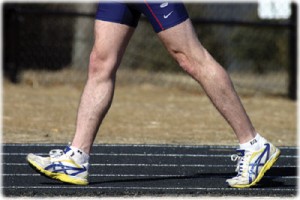
- The walking step is a rolling motion.
- Strike the ground first with your heel, your ankle flexed
- Roll through the step from heel to toe
- Push off with your toe
- Bring the back leg forward to strike again with the heel
- Flexible shoes will ensure you are able to roll through the step
- If your feet are slapping down rather than rolling through, your shoes are likely too stiff
- At first, your shin muscles (anterior tibialis) may tire and be sore until they are strengthened
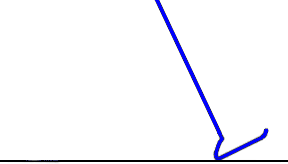 Show Them Your Sole:
Show Them Your Sole: - If you are really striking with the heel, someone watching you from in front will see the sole of your shoe on each step.
- Think about showing them your sole
- On your forward foot, let the ankle do the work of flexing your foot, don’t lift your foot with your toe
- A good push off by your toes on your rear leg will add power and speed to your step.
- Strike with heel. Back foot rolls through to push off
- Front foot continues to roll through step as back foot comes forward.
- Front foot strikes with heel and here we go again!
Leg Motion
Overstriding: is taking longer steps in front of your body in an attempt to increase speed. This is potentially harmful and is inefficient. Have someone observe you from the side. Work first on eliminating the overstriding.
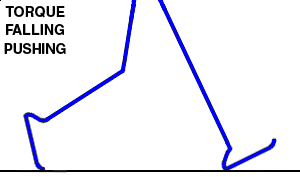 Keep your natural stride length, but learn to use it powerfully
Keep your natural stride length, but learn to use it powerfully- Your stride should be longer behind your body, where your toe is pushing off, rather than out in front of your body
- Think of keeping your rear foot on the ground the maximum amount of time, to really roll through the step and give a good push off with the toes
- The rear foot then passes under your body, knee flexing and driving forward but not up
- After the foot passes by the other leg, the ankle then flexes and knee straightens (still think of driving forward, not up with the knee) to present the heel to the ground
- The heel should strike the ground close to the front of the body, as it strikes the rear leg is rolling through the step and preparing to toe off powerfully and come forward
- Take more, smaller steps.
- Fast walkers train themselves to increase the number of steps they take per second and to get full use out of the back part of the stride
- Open up your stride behind your body by concentrating on getting a full roll through the rear foot and good push off with the rear toes
- If you find your feet slapping the ground in front, you likely have too stiff of shoes and/or weak shins. The shins will build with practice. But you will want to look into getting some more flexible shoes
Hips:
- Your hips should rotate with each stride front to back, not side-to-side.
- Do not concentrate on adding hip motion at first, it should come naturally as part of a good stride and push off
Warm-up

Start out at a slow, easy pace for each walking session Allow your muscles to warm up before you stretch, add speed or hills. Warm up for 5 minutes at this easy pace
Stretching
Stretching will add flexibility and can make your walking more comfortable.
Warm up for 5 minutes at an easy walking pace before stretching, never stretch cold muscles or you risk tearing them. Incorporate mobility exercises designed to take a muscle and joint through its range of motion.
Calf Stretches
Race walking uses calf muscles considerably more than other sports. Stretching the calves helps technique while preventing injuries. Calves are a complex muscle group, so a single stretch is not sufficient. If time permits, executing each of the four stretches presented is not overkill
- Place both hands at shoulder height on a wall or pole in front of your body.
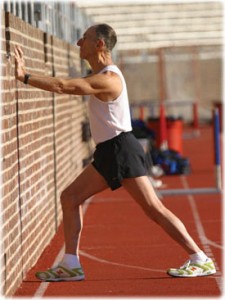
- Keep your arms fairly straight and your lead leg bent under your body.
- Now, place the heel of your rear leg 1½ to 2 feet behind your body.
- Keeping your rear leg fairly straight but not locked in position, place the heel of this foot on the ground. You should feel a stretch down the outer part of your rear-leg calf muscle. If you don’t, try moving your rear foot back a little farther (remember to place your heel back on the ground after you move your foot back).
- Throughout the stretch, your upper body should remain vertical and straight; do not bend forward.
- Alternate legs when finished.
Shin Stretches
When race walking with any form approximating proper technique, the first muscle group to feel in need of a stretch is the shins. Your shin muscles are taxed more in walking than in almost any other sport.
Since race walking forces you to land on your heel with toe pointed, it strains your shin. The body is clearly unaccustomed to this work and reacts by communicating its displeasure. Good stretching helps combat the discomfort. Both shin stretches below provide excellent benefits after walking and can also be executed while working out if your shins begin to burn or become otherwise bothersome.
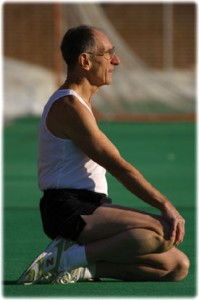 When your shins hurt, you will find it almost impossible to walk with your toe pointed at heel strike and achieve a proper roll through to your toes. If your shins bother you enough, they may lead you to land flat footed. Most flat-footed walkers have difficulty straightening their knees and must stretch their shins
When your shins hurt, you will find it almost impossible to walk with your toe pointed at heel strike and achieve a proper roll through to your toes. If your shins bother you enough, they may lead you to land flat footed. Most flat-footed walkers have difficulty straightening their knees and must stretch their shins- Start by sitting on the grass or soft carpet with your legs folded directly under your thighs. (Note foot position: shoe laces against the ground.)
- Use one hand to support your weight and the other to lift your knee.
- This lifting should send a stretch down your shin.
- Hold it 20 to 30 seconds, then switch legs.
Hamstring Stretches
Huge muscles that can get extremely tight, the hamstrings need to be stretched every day. This is especially true if you race walk in hilly areas that stress your hamstrings more than level-ground walking.
The most traditional hamstring stretch starts in a seated position.
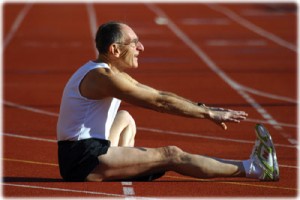
- Place one leg in front you.
- Bend your other leg with the sole of your foot facing towards your straight leg and knee pointed out.
- Keeping your back straight, lean forward from the hips, reaching towards your toes.
- Ideally, you should reach past your toes, but remember not to overstretch or bounce while trying to touch them; just stay within your comfort zone
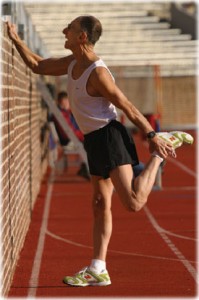 Quadriceps Stretch
Quadriceps Stretch The most common quadriceps stretch is actually the most effective for our needs.
- Standing next to a pole or wall for balance, raise the first leg behind the body, grabbing your foot.
- The upper part of the leg remains in a vertical position as you pull the leg upward.
- Pull your leg back.
- Be careful not to pull your leg laterally; this puts unneeded stress on the knee.
- Alternate legs.
Hip Stretches
It’s all in the hips. (Or should I say, race walkers do it with more hip action!) Proficient race walking technique requires excellent range of motion in the hips. Stretching properly increases this range, thereby enhancing hip-motion effectiveness. Of course, stretching also helps reduce injuries—in this case, to an essential component of a powerful stride.
The first hip stretch, though simple, requires a reasonably high curb.
- Stand at the curb with one leg on and the other hanging over it.
- Now, lower the hanging leg while keeping both legs straight and your foot parallel to the ground; feel the stretch in the hip opposite the curb.
- Repeat the exercise for the other hip.
While the second hip stretch presented is actually more effective, this hip stretch is excellent for wet days or in the middle of a workout or race.
Piriformis/Iliotibial Band Stretching
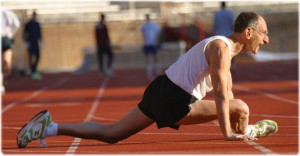
The Piriformis and Iliotibial (IT) Band are two little-known hard to spell body parts that can remain obscure until they begin causing great discomfort. The Piriformis is a small muscle in the buttocks; when tight, it stresses the sciatic nerve. The IT Band is made up of fibers that run along the outside of the thigh, attaching in the gluteal muscles and connecting below the knee. The IT Band gets irritated from either overuse or anatomical abnormalities.
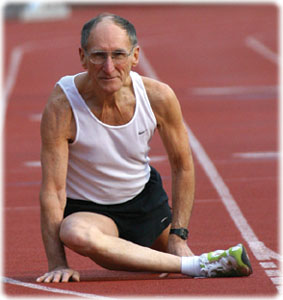 The following positions provide excellent stretches for this often-inaccessible area. You may find them a bit complicated, but if you follow the instructions carefully, you’ll find the effort worthwhile.
The following positions provide excellent stretches for this often-inaccessible area. You may find them a bit complicated, but if you follow the instructions carefully, you’ll find the effort worthwhile.- Using your arms to balance and sustain your body weight, reach one leg behind you for support while bending the stretching leg across and in front of your body.
- Slowly transfer your body weight to the front leg until you feel a stretch emanating from your buttocks.
- Take care not to lower your front leg onto the ground.
Seated Groin Stretch
At times race walking produces tightness in the groin. Regularly practicing this stretch reduces such discomfort while keeping this important area loose.
- Start by sitting with feet turned inwards and legs bent.
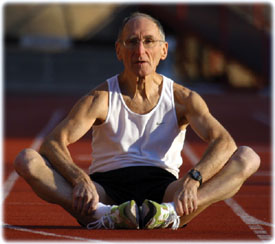
- Notice the knees fall as close to the ground as possible.
- As a mental reminder to lower your knees, place your arms atop your lower legs.
- Now lean forward from your midsection, keeping your back as straight as possible.
- Avoid lazy stretching, neither lowering the knees nor leaning forward. While this may produce a minimal groin stretch, the position is ineffective.
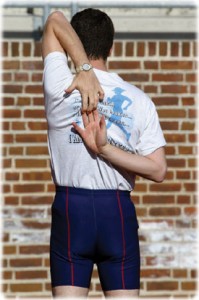 Shoulder Stretches
Shoulder StretchesRace walkers move their arms through a greater range of motion than runners or pedestrian walkers. By keeping your shoulders stretched and relaxed, you race walk more comfortably and efficiently.
Many people face challenges with this stretch, which is executed from a standing
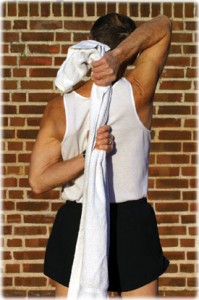 position.
position.- Attempt to clasp your hands behind your back, one from above and one from below.
- If you can reach, hold the position for 20 to 30 seconds; then reverse arms to stretch the other shoulder.
- If your hands remain a few inches apart from each other use a towel to complete the stretch.
- Walk your hands up the towel, positioning them as close together as possible, then reverse arms.

